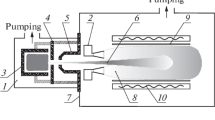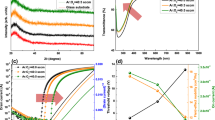Abstract
An optical method is proposed to calculate the dopant (e.g., boron or phosphorus) concentration in doped amorphous semiconductors. The basic principle of this method is that the effective density of valence electrons and the coordination number of the samples could be obtained by f-sum rule and dispersion energy model, respectively. A computational model is derived from this method and applied to doped amorphous silicon (a-Si:H) films with the results of spectroscopic ellipsometry and Fourier transform infrared spectroscopy measurements. It is found that the predicted concentrations of boron and phosphorus in doped a-Si:H samples are quite consistent with the actual results from secondary ion mass spectroscopy test, for the samples with the dopant content higher than 1021 cm−3.



Similar content being viewed by others
Data Availability Statement
Research data will be made available upon request. This manuscript has associated data in a data repository. [Authors’ comment: All data included in this manuscript are available upon request by contacting with the corresponding author.]
References
N.F. Mott, Electrons in disordered structures. Adv. Phys.-X 16(61), 49–144 (1967). https://doi.org/10.1080/00018736700101265
R.A. Street, Doping and the Fermi energy in amorphous silicon. Phys. Rev. L 49(16), 1187 (1982). https://doi.org/10.1103/PhysRevLett.49.1187
W. Beyer, W. Hilgers, P. Prunici, D. Lennartz, Voids in hydrogenated amorphous silicon materials. J. Non-Cryst. Solids 358(17), 2023–2026 (2012). https://doi.org/10.1016/j.jnoncrysol.2011.09.030
M.H. Brodsky, R.S. Title, K. Weiser, G.D. Pettit, Structural, optical, and electrical properties of amorphous silicon films. Phys. Rev. B 1, 2632 (1970). https://doi.org/10.1103/PhysRevB.1.2632
S.G. Greenbaum, W.E. Carlos, P.C. Taylor, Local bonding arrangements of boron in doped hydrogenated amorphous silicon. J. Appl. Phys. 56(6), 1874–1877 (1984). https://doi.org/10.1063/1.334203
M.T.M. Tanaka, T. Matsuyama, T. Matsuyama, T. Sawada, S. Tsuda, S.I. Nakano, H. Hanafusa, Y. Kuwano, Development of new a-Si/c-Si heterojunction solar cells ACJ-HIT (artificially constructed junction-heterojunction with intrinsic thin-layer). Jpn. J. Appl. Phys. 31, 3518–3522 (1992). https://doi.org/10.1143/JJAP.31.3518
M. Stutzmann, The doping efficiency in amorphous silicon and germanium. Philos. Mag. B 53(1), L15–L21 (1986). https://doi.org/10.1080/13642818608238962
Y. Lee, H. Kim, S.M. Iftiquar, S. Kim, S. Kim, S. Ahn, Y.-J. Lee, V.A. Dao, J. Yi, Study of stacked-emitter layer for high efficiency amorphous/crystalline silicon heterojunction solar cells. J. Appl. Phys. 116, 24 (2014). https://doi.org/10.1063/1.4905013
S.H. Wemple, M. DiDomenico, Optical dispersion and the structure of solids. Phys. Rev. Lett. 23(20), 1156–1160 (1969). https://doi.org/10.1103/PhysRevLett.23.1156
F. Demichelis, E. Minetti-Mezzetti, A. Tagliaferro, E. Tresso, P. Rava, N.M. Ravindra, Optical properties of hydrogenated amorphous silicon. J. Appl. Phys. 59(2), 611–618 (1986). https://doi.org/10.1063/1.336620
A. Hadjadj, N. Pham, P. Roca I Cabarrocas, O. Jbara, G. Djellouli, Ellipsometry investigation of the amorphous-to-microcrystalline transition in a-Si:H under hydrogen-plasma treatment. J. Appl. Phys. 107, 8 (2010). https://doi.org/10.1063/1.3393273
A. Fontcuberta i Morral, P. Roca i Cabarrocas, C. Clerc, Structure and hydrogen content of polymorphous silicon thin films studied by spectroscopic ellipsometry and nuclear measurements. Phys. Rev. B 69, 125307 (2004). https://doi.org/10.1103/PhysRevB.69.125307
A.H.M. Smets, W.M.M. Kessels, M.C.M. van de Sanden, Vacancies and voids in hydrogenated amorphous silicon. Appl. Phys. Lett. 82(10), 1547–1549 (2003). https://doi.org/10.1063/1.1559657
M.V.Z. Remeš, P. Torres, U. Kroll, A.H. Mahan, R.S. Crandall, Optical determination of the mass density of amorphous and microcrystalline silicon layers with different hydrogen contents. J. Non-Cryst. Solids 227–230, 876–879 (1998). https://doi.org/10.1016/S0022-3093(98)00207-5
W. Liu, L. Zhang, F. Meng, W. Guo, J. Bao, J. Liu, D. Wang, Z. Liu, Characterization of microvoids in thin hydrogenated amorphous silicon layers by spectroscopic ellipsometry and Fourier transform infrared spectroscopy. Scr. Mater. 107, 50–53 (2015). https://doi.org/10.1016/j.scriptamat.2015.05.018
J.J. Hopfield, Sum rule relating optical properties to the charge distribution. Phys. Rev. B 2(4), 973–979 (1970). https://doi.org/10.1103/PhysRevB.2.973
S.H. Wemple, M. DiDomenico, Behavior of the electronic dielectric constant in covalent and ionic materials. Phys. Rev. B 3(4), 1338–1351 (1971). https://doi.org/10.1103/PhysRevB.3.1338
G.E. Jellison, F.A. Modine, Parameterization of the optical functions of amorphous materials in the interband region. Appl. Phys. Lett. 69(3), 371–373 (1996). https://doi.org/10.1063/1.118064
W. Liu, L. Zhang, S. Cong, R. Chen, Z. Wu, F. Meng, Q. Shi, Z. Liu, Controllable a-Si:H/c-Si interface passivation by residual SiH4 molecules in H2 plasma. Sol. Energy Mater Sol. Cells 174, 233–239 (2018). https://doi.org/10.1016/j.solmat.2017.09.009
E. Shiles, T. Sasaki, M. Inokuti, D.Y. Smith, Self-consistency and sum-rule tests in the Kramers–Kronig analysis of optical data: applications to aluminum. Phys. Rev. B 22(4), 1612–1628 (1980). https://doi.org/10.1103/PhysRevB.22.1612
T. Haage, U.I. Schmidt, H. Fath, P. Hess, B. Schröder, H. Oechsner, Density of glow discharge amorphous silicon films determined by spectroscopic ellipsometry. J. Appl. Phys. 76(8), 4894–4896 (1994). https://doi.org/10.1063/1.357267
J.P.F.C. Ance, J.M. Berger, F. De Chelle, Calculation model for valence electrons and hydrogen concentration in a-Si:H. Phys. Stat. Sol. (B) 113, 105 (1982). https://doi.org/10.1002/pssb.2221130110
C.A.N.M. Ravindra, J.P. Ferraton, J.M. Berger, F. De Chelle, S. Robin, Refractive index dependency on optical gap in amorphous silicon-part II. Si prepared by chemical vapour deposition. Infrared Phys. 23, 223–232 (1983). https://doi.org/10.1016/0020-0891(83)90040-4
C.A.N.M. Ravindra, S.P. Coulibaly, F. De Chelle, J.M. Berger, J.P. Ferraton, A. Donnadieu, Refractive index dependency on optical gap in amorphous silicon-part I. Si prepared by glow discharge. Infrared Phys. 23, 99–108 (1983). https://doi.org/10.1016/0020-0891(83)90019-2
D. Franta, D. Nečas, L. Zajíčková, I. Ohlídal, J. Stuchlík, D. Chvostová, Application of sum rule to the dispersion model of hydrogenated amorphous silicon. Thin Solid Films 539, 233–244 (2013). https://doi.org/10.1016/j.tsf.2013.04.012
D. Franta, D. Nečas, L. Zajíčková, I. Ohlídal, J. Stuchlík, Advanced modeling for optical characterization of amorphous hydrogenated silicon films. Thin Solid Films 541, 12–16 (2013). https://doi.org/10.1016/j.tsf.2013.04.129
D.J.L.R.E. Norberg, P.A. Fedders, Non-bonded hydrogen in a-Si:H. J. Non-Cryst. Solids 227, 124–127 (1998). https://doi.org/10.1016/S0022-3093(98)00267-1
K. Mui, F.W. Smith, Optical dielectric function of hydrogenated amorphous silicon: tetrahedron model and experimental results. Phys. Rev. B 38(15), 10623–10632 (1988). https://doi.org/10.1103/PhysRevB.38.10623
J.B. Boyce, S.E. Ready, Nuclear-magnetic-double-resonance investigation of the dopant microstructure in hydrogenated amorphous silicon. Phys. Rev. B 38(16), 11008–11018 (1988). https://doi.org/10.1103/PhysRevB.38.11008
W. Liu, J. Shi, L. Zhang et al., Light-induced activation of boron doping in hydrogenated amorphous silicon for over 25% efficiency silicon solar cells. Nat. Energy 7(5), 427–437 (2022). https://doi.org/10.1038/s41560-022-01018-5
Acknowledgments
We acknowledge the useful discussions about this method with Dr. Zhuopeng Wu. This work was supported by projects of the National Natural Science Foundation of China (62074153 and 62004208), Strategic Priority Research Program and the Joint Fund of Chinese Academy of Sciences (XDA17020403), and the project of Shanghai Municipal Science and Technology Committee (19DZ1207602 and 20dz1207100).
Author information
Authors and Affiliations
Corresponding authors
Ethics declarations
Conflict of interest
The authors hereby declare that they have no known competing financial interests or personal relationships that could have appeared to influence the work reported in this paper.
Electronic supplementary material
Below is the link to the electronic supplementary material.
Appendix
Appendix
Assuming there is a binary or ternary amorphous semiconductor. The molecular formula is Ax1Bx2C1 − x1 − x2, where the number of outshell electrons in element A, B and C is a, b and c, respectively. And nA, nB, nC are atomic concentrations per unit volume.
Considering the contributions of the effective number of valence electrons from each element, we can deduce that:
With the dispersion energy model, we have:
Assuming that element C does not exist, it is now possible to calculate the content of each element in the binary samples:
For ternary samples, one of these elements needs to be characterized by other means. In the previous discussion, we used FTIR to obtain the H content for doped a-Si:H films. Here we assume that the content of element B can be obtained, we can deduced that:
Rights and permissions
About this article
Cite this article
Li, Z., Zhang, L., Liu, W. et al. Optical method for calculating the dopant concentration of doped amorphous semiconductors. Eur. Phys. J. Plus 137, 862 (2022). https://doi.org/10.1140/epjp/s13360-022-03027-5
Received:
Accepted:
Published:
DOI: https://doi.org/10.1140/epjp/s13360-022-03027-5




